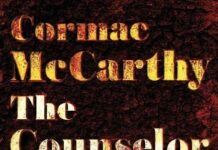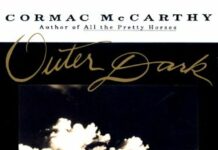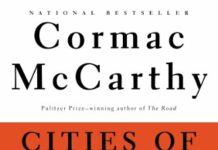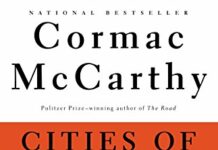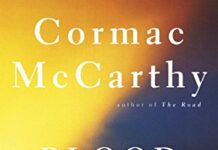
Ebook Info
- Published: 2010
- Number of pages: 434 pages
- Format: EPUB
- File Size: 0.32 MB
- Authors: Cormac McCarthy
Description
NATIONAL BESTSELLER • The second volume of the award-winning Border Trilogy—from the Pulitzer Prize–winning author of The Road—fulfills the promise of All the Pretty Horses and at the same time give us a work that is darker and more visionary, a novel with the unstoppable momentum of a classic western and the elegaic power of a lost American myth.In the late 1930s, sixteen-year-old Billy Parham captures a she-wolf that has been marauding his family’s ranch. But instead of killing it, he decides to take it back to the mountains of Mexico. With that crossing, he begins an arduous and often dreamlike journey into a country where men meet ghosts and violence strikes as suddenly as heat-lightning–a world where there is no order “save that which death has put there.”An essential novel by any measure, The Crossing is luminous and appalling, a book that touches, stops, and starts the heart and mind at once.Look for Cormac McCarthy’s new novel, The Passenger.
User’s Reviews
Reviews from Amazon users which were colected at the time this book was published on the website:
⭐I always find McCarthy books very difficult to review for some reason, even though each one has been powerful in their own way and a thoughtful experience. I’ve enjoyed every Cormac McCarthy book I’ve read (The Crossing being my fourth read) and feel like there are some signature McCarthy staples that a reader experiences when venturing forth into one of his novels.The novel here is aptly named because in The Crossing we have a focus on various journeys of sorts, both literal and figurative, that are experienced namely by our protagonist, Billy Parham. Within the novel, there are a total of three literal crossings, one of which is Billy’s journey into Mexico after capturing a she-wolf that was terrorizing the father’s livestock. Along this path, Billy encounters allies, foes, dangers, and insights into the land.One of the most notable qualities of McCarthy (alongside the lack of quotations for dialogue) is his stream of conscious dreamlike prose that seems to go in line with the mythical effect of the plot. I felt like I could literally get lost in the prose (I mean, in an effective way). And this adds to the literary experience, as in The Crossing themes such as coming of age, loss of innocence, facing the harsh realities of life. There is a constant prevailing commentary on the human existence that is focus.This novel has less a linear styled plot but works instead more so as a series of connected episodes or parts that take us to one larger conclusion. Another notable aspect is McCarthy’s distinct ability to use the oral tradition of storytelling as part of both the literal and symbolic journey. In this way, we are given a story within a story, and I think this adds to the mythical, ponderous quality that The Crossing establishes.This was yet another powerful reading experience from McCarthy, and I look forward to finishing with the last in the Border trilogy, Cities of the Plain.
⭐This is the second volume of Cormac McCarthy’s aptly named “Border Trilogy.” After a reading of the first,
⭐, I knew I would complete the trilogy. Among other reasons, the novels are “set in my backyard,” if one takes an expansive view of same: the border being the one between the United States and Mexico. In the first volume, American adolescents from Texas crossed into Mexico to “find their way in the world.” In this volume, “the crossing” of the adolescent (a different one, different time period) is from New Mexico into Mexico, and the purpose is a bit different.It is the late `30’s, what would be the waning days of the Great Depression, and Billy Parham, 16, and his brother Boyd, 14, are growing up on a “hard-scrabble” ranch in Hidalgo County, NM, in the area normally referred to as “the boot heel” of New Mexico. It is an area still so remote that probably less than one New Mexican in a 1,000 has visited it; I’ve been there only once, driving to Columbus, yet still missing the portion McCarthy so lyrically describes: the Animas Mountains and valley. This book encouraged me to make amends for this oversight.The two boys meet a hungry Indian, and obtain food for him, an event which foreshadows developments in an unlikely way. Over the past decade there have been efforts to re-introduce wolfs into the wild of NM (with considerable opposition), so it was ironic to read of the time that they had been hunted to extinction in NM, since they are no friend to the cattle ranchers. Nonetheless, in McCarthy’s account, there is a wolf that has come up from the mountains of Mexico, and is killing cattle. The two boys, and their dad set out to trap it, and McCarthy demonstrates considerable narrative skills depicting the process whereby even a “clever” wolf is trapped. The author never veers to a “New Age” outlook on the interactions between man and wild animals, but he does describe the action with considerable empathy for the wolf, as well as the understandable reaction of Billy when the wolf is trapped: he will not kill the wolf, rather he will take it back to the mountains of Mexico, and release it. There was no border fence in the `30’s, so Billy simply takes his horse, and now “his” wolf across. For anyone, but particularly for a 16 year old American boy, it is an adventure, requiring an essential ability to “think on your feet” in a new environment. McCarthy “style” involves long descriptive passages on the landscape, with numerous technical terms, particularly those involving the skills of horse-handling. And his narrative also involves interspersing passages of Spanish in the dialogue, a language Billy speaks, thanks to his maternal grandmother. Other reviewers who only speak English have complained of this. Although passages in French are more common in narratives of English, and I can read French, the Spanish was a bit more of a challenge, and did require a Spanish dictionary in the lap while reading: hopefully I’m a bit wiser for the process.Billy Parham’s initial purpose, taking the wolf back to Mexico ends on page 125. There are more than 300 pages to go. Billy is joined by his brother Boyd, in both purposeful, and then seemingly random wanders in northern Mexico. The “kindness of strangers” is very much in evidence, as they both are often penniless. And the occasional terrifying violence that mars the peace of both countries is also in evidence. Through flashbacks, the revolution(s) in Mexico, which manage to kill off so much of the “best and brightest” usually of the male population, is also depicted. Billy stumbles into a church and finds an old woman praying. McCarthy brilliantly captures one slice of Mexican history and society with the following:”He knew her well enough, this old woman of Mexico, her sons long dead in that blood and violence which her prayers and her prostrations seemed powerless to appease. Her frail form was a constant in that land, her silent anguishing. Beyond the church walls the night harbored a millennial dread panoplied in feathers and the scales of royal fish and if it yet fed upon the children still who could say what worse wastes of war and torment and despair the old woman’s constancy might not have stayed, what direr histories yet against which could be counted at least nothing more than her small figure bent and mumbling, her crone’s hands clutching her beads of fruitseed. Unmoving, austere, implacable. Before just such a God.”The Crossing? Billy crosses the American-Mexican border at least five times, yet the title is in the singular. I suspect it refers to that much tougher crossing he made, from adolescence into manhood. I welcome comments. 5-stars for an essential American novel.
⭐The Crossing feels much longer than 400 plus pages and would have been a better read at around half the length. When McCarthy is good, the writing is extraordinarily powerful, with his prose conveying the harshness and beauty of the US/Mexico landscape, along with the friendliness and hostility of the people who live there. He also writes with real power about the connection between man and animals, and indeed some of the most moving writing here is about wolves and horses.The Crossing meanders on way too long though, with long passages of religious pontifications adding little to the story, and there is no real sense of narrative urgency to the story of Billy Parham as he lives out a precarious and brutal life on the border. The book has an old, wild west feel about it, although it is set in the 1930s-40s. At times, it is like Jude The Obscure set in the USA, such is its unremitting bleakness and strange, haunting beauty. Overall, worth the effort, but hard going at times.
⭐Just a sublime novel by McCarthy, who seems incapable of writing a bad book. Dark and lyrical, it transports you to the south-western ranches of the US. Billy and Boyd are perfectly realised characters, and you are 100% invested in their journey. The writing style is sparse and elegant. Beautiful.
⭐After reading All The Pretty Horses I was keen to read the next part in the border trilogy. I have to say that McCarthy certainly did not disappoint and I enjoyed reading The Crossing even more than it’s predecessor.The story follows Billy Parham, a 17 year old boy living with on a cattle ranch near the Mexican border. Set in the late thirties we journey across the southern US and into Mexico in three perilous adventures. Cormac describes an epic landscape steeped in a terrible history. He manages to capture the wild and dangerous nature of Mexico at that time whilst portraying it’s people as being largely generous and kind despite their obvious hardships.The novel deals with suffering, bereavement, the uncertain nature of life and loosing faith in God. Billy encounters people who not only tell him their often remarkable tales but offer unique philosophies. A Dark, remarkable, thought provoking read.
⭐I am a confirmed fan, so I knew what to expect – even so, this is an unbelievably sad story that offers few, if any, consolations. But it is written in McCarthy’s peerless prose, and that in itself is enough to commend it. The story is actually quite slight, focusing on Billy Parham, a very young cowboy in the 1930’s who embarks on a mad journey to repatriate a wolf in Mexico and ends up having his whole life turned upside down. All McCarthy’s trademarks are here: beautiful, lyrical descriptions of the countryside and wider environment; a wonderful expression of the relationship between man and horse; an unblinking story of poverty, mistrust, hatred and death; and a compelling central character, flawed, headstrong, loyal and tragic. Do not read this if you like happy endings!
⭐I’d say at least 3% of the book is in Spanish with no translation (at least in the kindle edition I read) I found this both annoying and frustrating. He is a wonderfully gifted writer no doubt about that, but I found this particular tale for the most part unremittingly GRIM!!! You’ve been warned!
Keywords
Free Download The Crossing: Book 2 of The Border Trilogy in EPUB format
The Crossing: Book 2 of The Border Trilogy EPUB Free Download
Download The Crossing: Book 2 of The Border Trilogy 2010 EPUB Free
The Crossing: Book 2 of The Border Trilogy 2010 EPUB Free Download
Download The Crossing: Book 2 of The Border Trilogy EPUB
Free Download Ebook The Crossing: Book 2 of The Border Trilogy
